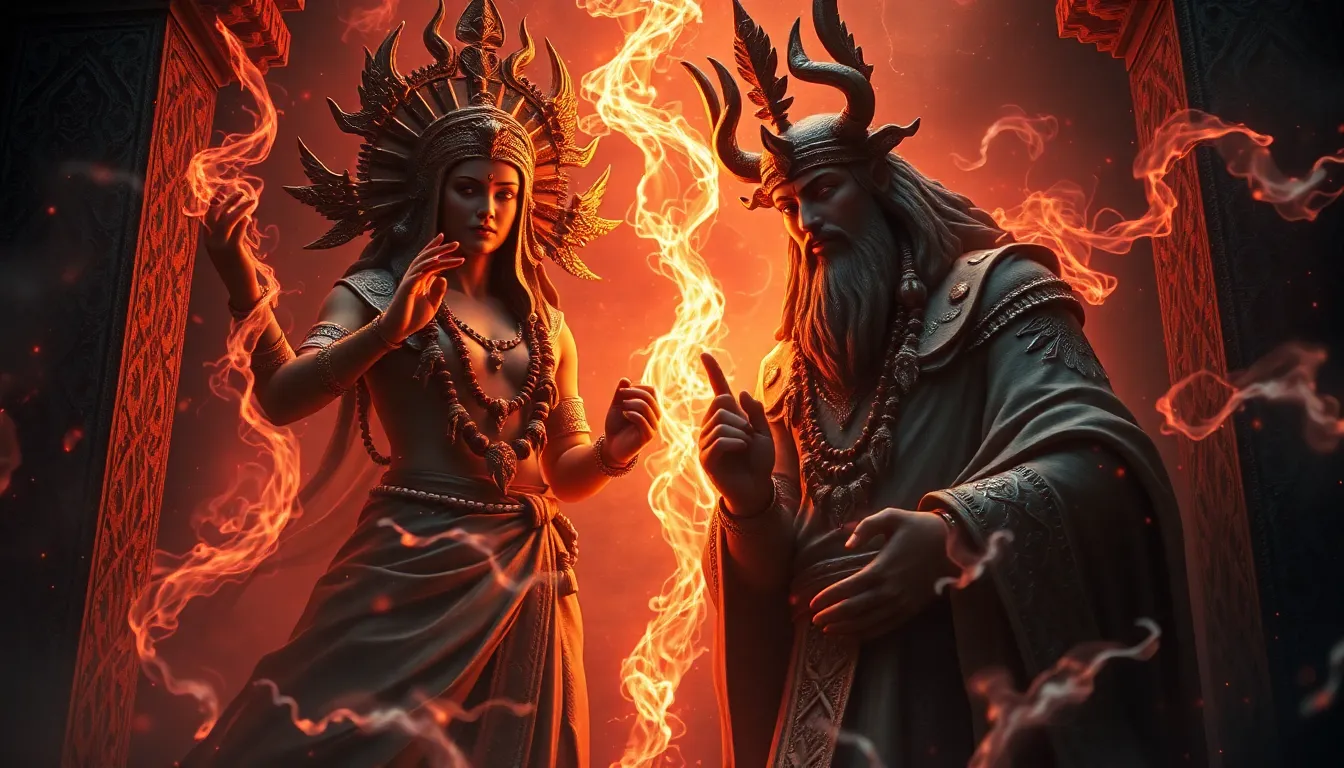The Rich Tapestry of Thai Mythology
Thailand's mythology is a vibrant tapestry woven with ancient beliefs, stories of gods and demigods, and tales of heroic deeds and epic battles. It reflects the country's long and fascinating history, drawing inspiration from Hindu and Buddhist traditions. Thai myths offer a unique perspective on the human condition, exploring themes of love, loss, betrayal, redemption, and the enduring cycle of life and death. These stories have been passed down through generations, shaping Thai culture and providing valuable lessons about morality, compassion, and the consequences of our actions.
Betrayal as a Recurring Theme in Thai Mythology
Betrayal is a recurring theme in Thai mythology, serving as a powerful catalyst for conflict and transformation. These stories often explore the complexities of human nature, highlighting the fragility of trust and the devastating consequences of broken promises. The act of betrayal is not always deliberate, sometimes stemming from ignorance, misunderstanding, or manipulation by malevolent forces. Nevertheless, it often leads to suffering, loss, and a quest for justice or redemption.
The Myth of Phra Ruang and the Betrayal of a Brother
One of the most well-known tales of betrayal in Thai mythology is the story of Phra Ruang, a legendary king of the Sukhothai era. The myth recounts the tragic tale of two brothers, Phra Ruang and Phra Phrom, who were both vying for the throne. Driven by ambition and jealousy, Phra Phrom betrayed his brother, plotting to usurp the throne. Phra Ruang, initially unaware of his brother's treachery, was eventually forced to confront the betrayal, leading to a fierce battle and the tragic death of Phra Phrom. This story highlights the destructive nature of envy and the importance of loyalty and trust within familial bonds.
The Story of Nang Nork and her Betrayal by Her Husband
Another powerful tale of betrayal in Thai mythology is the story of Nang Nork, a beautiful and virtuous woman who is betrayed by her husband, Khun Chang. Khun Chang, blinded by greed and jealousy, falsely accuses Nang Nork of adultery and sentences her to death. However, Nang Nork is saved by Khun Phaen, a righteous warrior who falls in love with her. Khun Chang, consumed by rage, challenges Khun Phaen to a duel, ultimately leading to his own demise. This story emphasizes the consequences of jealousy, the importance of justice, and the power of love to overcome betrayal.
Karma and the Concept of Redemption in Thai Mythology
Karma, a central concept in Buddhist philosophy, plays a significant role in Thai mythology. It emphasizes the belief that actions have consequences, both in this life and in the next. Betrayal, often driven by negative emotions like greed, jealousy, or anger, creates negative karma, leading to suffering and misfortune. However, Thai mythology also offers hope for redemption. Through acts of kindness, compassion, and self-reflection, individuals can strive to overcome their negative karma and achieve a more positive future.
The Role of Supernatural Beings in Tales of Redemption
In Thai mythology, supernatural beings often play a crucial role in tales of betrayal and redemption. These beings, like the gods, spirits, and mythical creatures, often serve as agents of divine justice, intervening in human affairs to balance the scales of karma.
For example, the powerful goddess Phra Mae Thorani, known as the Earth Mother, is often invoked in stories of redemption. She represents the nurturing and compassionate aspects of the divine, offering protection and guidance to those seeking forgiveness and a path toward a better life.
Other supernatural beings, like the benevolent spirits known as "thep," can also act as intermediaries in the process of redemption. These spirits may bestow blessings, offer wisdom, or even provide supernatural assistance to those striving to make amends for their past actions.
The intervention of these supernatural beings adds a layer of mystery and intrigue to tales of redemption, reaffirming the belief that even in the face of betrayal, divine forces can offer guidance and a chance for renewal.
The Metamorphosis of Characters: Redemption through Transformation
Redemption in Thai mythology is often achieved through a transformative process, where characters undergo profound changes in their nature, beliefs, or actions. This metamorphosis can be prompted by a range of factors, including the realization of wrongdoing, the influence of benevolent beings, or the power of love and forgiveness.
One example of this transformative journey is found in the story of the mythical creature, the "Naga," a serpentine being associated with both power and wisdom. In some tales, Nagas who have committed acts of betrayal or cruelty may undergo a transformative process, shedding their negative tendencies and embracing compassion and selflessness. This metamorphosis often involves a symbolic shedding of their serpent scales, representing the casting off of their former selves.
Such stories illustrate the possibility of redemption, even for those who have previously acted in harmful ways. They highlight the importance of personal growth, self-reflection, and the potential for positive transformation through conscious effort and a willingness to change.
The Influence of Buddhist Principles on Thai Mythology
The influence of Buddhist principles is deeply woven into the tapestry of Thai mythology. The concept of karma, the law of cause and effect, permeates Thai stories, emphasizing the consequences of our actions, both in this life and the next. Betrayal often results in negative karma, leading to suffering and misfortune, while acts of kindness, compassion, and forgiveness contribute to positive karma, paving the way for redemption.
The Buddhist principle of "Metta," which translates to "loving-kindness" and "compassion," is also a central theme in many Thai myths. This principle encourages empathy, forgiveness, and the desire to alleviate suffering, demonstrating the power of positive intentions in achieving redemption.
Furthermore, the Buddhist belief in rebirth and the cycle of reincarnation provides a framework for understanding the process of redemption. It suggests that through repeated cycles of life and death, individuals have opportunities to learn from their past mistakes, cultivate positive qualities, and eventually achieve liberation from suffering.
The Significance of Tales of Betrayal and Redemption in Thai Culture
Tales of betrayal and redemption in Thai mythology are not merely entertaining narratives; they serve as powerful cultural touchstones, providing insights into the values, beliefs, and aspirations of the Thai people. These stories embody the complexities of human nature, highlighting the potential for both good and evil, and emphasizing the importance of ethical conduct, compassion, and the pursuit of redemption.
They offer valuable lessons about the consequences of our actions, the power of forgiveness, and the importance of striving for a better future. These stories serve as reminders that even in the face of betrayal and suffering, there is always hope for healing, growth, and transformation. They encourage individuals to confront their shortcomings, seek forgiveness, and work towards a more virtuous life.
Modern Interpretations of Traditional Thai Myths
In contemporary Thailand, traditional myths continue to resonate with audiences, inspiring creative adaptations in various forms of art and entertainment. Writers, artists, filmmakers, and musicians draw inspiration from these timeless tales, reinterpreting them for modern audiences while preserving their core themes and messages.
These modern interpretations often reflect the changing perspectives and societal values of contemporary life, offering fresh perspectives on traditional narratives. For example, some adaptations might explore the complexities of betrayal in modern relationships, or they might highlight the struggle for redemption in a world grappling with social injustice or environmental challenges.
These contemporary interpretations demonstrate the enduring power of Thai mythology, showcasing its relevance to contemporary issues and its ability to inspire reflection, empathy, and a deeper understanding of the human condition.
FAQ
How can I Learn More About Thai Mythology?
There are many ways to learn more about Thai mythology. You can explore books, scholarly articles, and websites dedicated to Thai culture and folklore. Attending lectures, workshops, or festivals focused on Thai mythology can also offer valuable insights and immersive experiences. Additionally, many museums and cultural centers in Thailand and around the world host exhibitions showcasing Thai mythology through art, artifacts, and multimedia displays.
Are There Any Modern Examples of Thai Mythology in Popular Culture?
Yes, Thai mythology continues to inspire modern creative works. For example, the epic Ramayana, a foundational text in both Hindu and Thai mythology, has been adapted into numerous films, television shows, and even video games. Similarly, the tale of Nang Nork and Khun Chang has been reinterpreted in various forms, including operas, dramas, and contemporary novels.
What is the Significance of the Serpent in Thai Mythology?
The serpent, or "Naga," plays a prominent role in Thai mythology, often representing both power and wisdom. They are sometimes depicted as benevolent beings, associated with water, fertility, and the protection of the land. However, in other stories, they can embody negative qualities like greed, jealousy, or betrayal. The serpent's dual nature reflects the complexities of existence and the potential for both good and evil within all beings.



